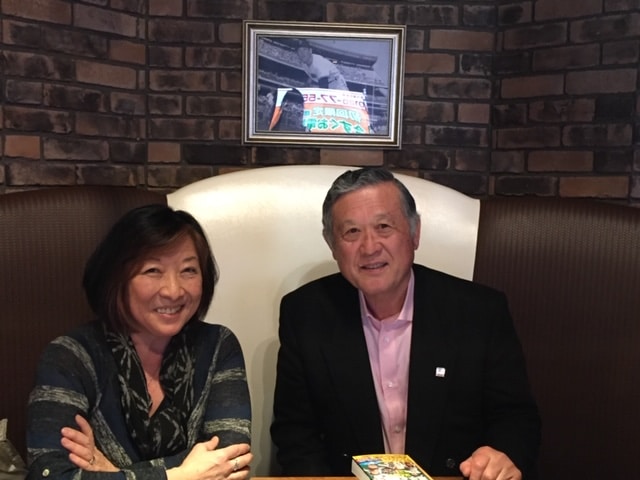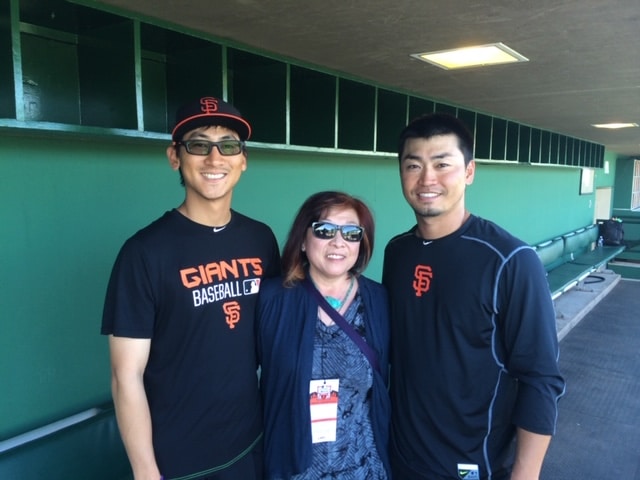Yuriko Gamo Romer, maker of documentary films such as the acclaimed “Mrs. Judo: Be Strong, Be Gentle, Be Beautiful,” joined JapanBall’s Chatter Up! on July 9 to discuss her upcoming film “Diamond Diplomacy,” which discusses and highlights the shared love of baseball between the United States and Japan.
Shane:
Welcome. Thank you for joining us. It’s been great talking to you over the past few weeks and I’m happy to have you on here.
Yuriko:
Thanks for having me, Shane. It was really wonderful that you contacted me and, and I can share with everyone here that I was completely shocked that we’d never met before.
Shane:
I agree with that, but here we are, so now we’re going to be good partners in this. So for anyone who’s not familiar with Yuriko, I just want to give a short introduction here before we jump into everything. Yuriko is an award-winning director based in San Francisco. She has a Master’s in documentary filmmaking from Stanford, is a student Academy Award winner, National Academy of Television Arts and Sciences scholar, American Association of Japanese University woman scholar, amongst many other accolades. Her most recent documentary, “Mrs. Judo: Be Strong, Be Gentle, Be Beautiful” is an amazing film. That is about Keiko Fukuda, the first woman to attain the 10th degree black belt in judo. It went to 25 film festivals internationally, won the best documentary [category] at the International Sports Film Festival in Moscow and was broadcast nationally on PBS. So, we look forward to “Diamond Diplomacy,” her current project, getting similar, if not better accolades. “Diamond Diplomacy” explores the relationship between Japan and the U.S. via their shared love of baseball. And that’s why we’re here today – to talk about “Diamond Diplomacy.” So Yuriko, can you just talk a little bit please about how you decided to embark on this project?
Yuriko:
Sure, I’d love to do that. And actually, I have to quickly say that there’s somebody on this call, my friend Dave Dempsey, who is on here somewhere, is the son of Con Dempsey and Con Dempsey was a pitcher for the San Francisco Seals. He was part of the tour in 1949 that went to Japan; it was a goodwill tour. The main thing that got me was that Con Dempsey had traveled through Japan on the tour with his movie camera, and so I had some home movies to start off with, and it was the first time I’d heard the story… it was really lovely. That story [was] the beginning of all this. And then I started doing research and opened up a whole Pandora’s Box of really interesting stuff. But I basically felt like, ‘okay, I could make a little film about the 1949 tour, but there’s just so much interesting stuff about the history of the connection between the two countries through baseball,’ so it started this big project.
Shane:
I know you’re a big Giants fan. What’s your history with baseball and being a fan and being in San Francisco and whatnot?
Yuriko:
I played softball as a kid. I’m not particularly good, but I’m actually really good at getting on first base for some reason; I think it was the running. But beyond that it was, I didn’t really become a professional baseball fan until I moved to New York. And then I was working in advertising, and I had some Yankee fan friends so we were always going to these Yankee games, and I learned to enjoy professional baseball and going to the games. And then I moved to San Francisco, and then I got married and then I had a kid, and my husband is from Cincinnati, so he grew up a Reds fan, but as soon as the kid was born in San Francisco, we realized we needed to be Giants fans, so we’re Giants fans. And then my kid played baseball and he would come home from the games and he would talk about all the little nuances. And I think the more that came into my being I, the more I loved baseball and understood the little bits and pieces of it.
Shane:
Well, we’re glad that you developed such an affinity for it and had Dave and his family to help with that, because I think we’re all gonna benefit; we’re really looking forward to seeing the film. I don’t really think there’s anything like it of its kind; having an English language film that really covers the history of things is really exciting. Can you talk a little bit about the filmmaking process and what that’s been like? I know you have some stories and some photos you wanted to share, but we’re just curious about how you met with all these different people.
Yuriko:
Anybody who knows anything about documentary filmmaking, you realize that you start with an idea, but then it doesn’t always go in the direction that you think it’s gonna go. So, in my case, the whole 1949 tour was a great idea; I thought I could make a little film about it, I started doing all this research, and I realized that Japan was introduced to baseball in 1872. There’s [the] 150th anniversary coming up in a couple years. And I thought that [was] amazing, because it’s been in Japan almost as long as it was really popular in the United States, because it was after the Civil War that it started becoming very popular in [the USA]. So that started that [aforementioned] Pandora’s Box and then all of a sudden, I learned about the 1934 Babe Ruth Tour, which Rob Fitts [helped with] (Editor’s Note: Rob Fitts contributed and was interviewed for the production of the documentary.)
I started just learning more and more bits and pieces. And so, I started having to just look into stuff, [which] meant trying to meet current players that were coming. I do have to say that this is the first time I’ve ever done a film that involves celebrities, and I’ll be happy never to have to do that again, because dealing with agents trying to get interviews and trying to get to see people, but people actually have been pretty helpful. It’s just none of them like [Nori] Aoki was really great. And then he left you know, I keep losing these characters, but I did collect some photos:

Gamo Romer and Masanori Murakami at the MLB Cafe in Japan. 
Gamo Romer with Nori Aoki, then a pitcher for the San Francisco Giants. 
Gamo Romer with Dusty Baker during his managerial tenure with the Washington Nationals. 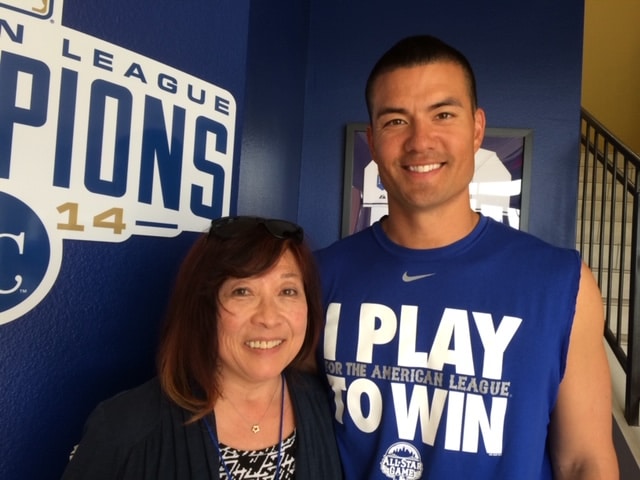
Gamo Romer with Jeremy Guthrie, then a pitcher with the Kansas City Royals. 
Gamo Romer on the Nationals’ foul line during Opening Day, 2016. 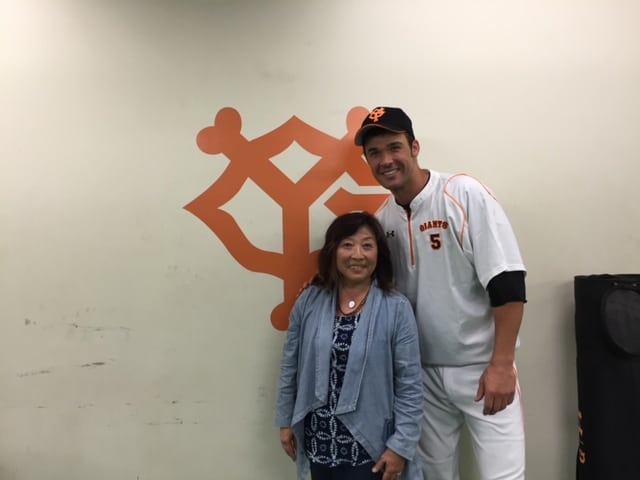
Gamo Romer with Garrett Jones of the Yomiuri Giants. 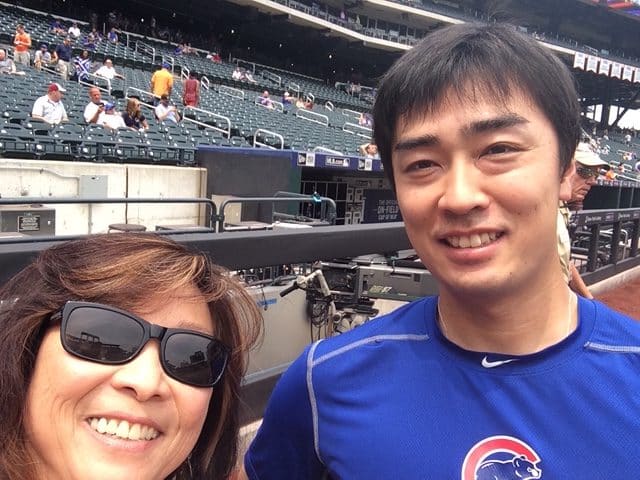
Gamo Romer with Tsuyoshi Wada during his tenure with the Chicago Cubs.
This is part of doing a film like this is that you end up with access. Also, the other thing that you’re going to see is that I’ve been invited into the clubhouse and have spent some time hanging out with these players. One funny story. [In one photo,] If you look on the table, in the middle of the clubhouse there, you see a bunch of Starbucks coffee. When I first walked in there, there were about 60 of them on the table, and I thought, ‘wow, these guys are really spoiled. They get their custom orders brought in from Starbucks every day.’ And one of the guys was like, ‘No, no, no. What happened was one of the rookies made a mistake. And he was late to the meeting. So this was his penance, he had to go and pick up custom orders for every one of the players. And he had to show up at Starbucks in his uniform. And so then he shows up with all these coffees and puts them on the table. And the ones that want the coffee come and get them and then they go, and you know, they’re just all just sort of very cavalier about this whole thing. And I was there to meet Kenta Maeda. And they told me to show up at 8:30 in the morning, and the trainer comes in and says ‘I’m really sorry he’s got to meet with the trainers this morning. And he’s going to be a little delayed. Can you just wait here?’ And I was like, ‘Well, yeah, I’m not going anywhere else because it took me so much effort to get to this point.’ So I hung out in the clubhouse from 8:30 until 11:30 in the morning! So you can imagine these guys are all looking at us like ‘what are you doing here?’ And one of them came over and he started going, ‘Oh, well, you guys want some coffee?’ and he brought me some coffee. I said, ‘What? I don’t really want a cold coffee.’ He’s like, ‘Oh I’ll go heat it up for you.’ And then you know, we just ended up just sort of shooting the shit with all these guys and just playing around, and there. They were a fun group in the clubhouse.
(In her travels to different clubs, Gamo Romer also visited Washington D.C. for Opening Day, where she had a run-in with then reigning NL MVP, Bryce Harper)
What happened was Mashi (Masanori Murakami) and I had been invited to speak at a luncheon at the Sasakawa Peace Foundation in DC. So we had spoken at the luncheon like the day before, and Mashi of course figured out the next day was going to be Opening Day and he said he wanted to go to the game and I’m thinking to myself, ‘I don’t have any way of getting tickets or anything like that.’ So he’s like, ‘Okay, I’ll handle it.’ So I think he called Dusty Baker… [During the opening day ceremony,] I’m standing in a spot and when they sort of started the ceremony to present the MVP, suddenly, [Harper] was like four feet from me, taking all these pictures. There was one inning and then it got rained out. So we were standing inside most of the time.
(After sharing more photos, Gamo Romer shared the first of three clips from her upcoming documentary; this clip focused on baseball in Japan before World War II, including a visit from the legendary Babe Ruth.)
Shane:
The one thing I really liked about that is that picture I’ve seen before of the Babe signing a ball for the Prince of Japan. I think it shows the level of celebrity that he had reached when the Prince of Japan is even admiring him.
Yuriko:
One thing that I forgot to mention earlier, but I definitely want to say is that you guys got to see Julia Ruth Stevens, Babe Ruth’s daughter. And that was [about] five years ago, she was 99 just about to turn 100, and 2 days ago, July 7, would have been her 104th birthday; she passed away last year. But she granted me that interview. I remember I got in touch with her son, the grandson, and he said, ‘Oh, Mom would love to talk to you about it.’ And she was the last surviving person from that 1934 tour. And she granted me what ended up being her last video interview. So it was lovely to hear the little stories, and she admitted to me things like she dated two of the ballplayers, even though her dad didn’t want her dating baseball players. She remembered fondly traveling to Japan.
Shane
It’s interesting [that] they talk about how Japan militarized the game and [even] eliminated the use of English words. When baseball first started in Japan, they kind of had their own approach and it’s kind of Samurai, Bushido approach. And then they had this big infatuation with American baseball. And then [after World War II there was] backlash against the Americans; maybe that helped to create the Japanese version of the game. Whereas other countries maybe like Latin America, maybe, don’t have a distinct version, as there wasn’t this concerted effort to really make it their own?
Yuriko:
I think that’s probably true. When it was taken to Latin America, it was almost set up there to be a minor league for the United States I think. But Japan as a country also has a completely different culture. I think that was part of it, how they absorbed the sport and turned it into their own because that’s what they like to do.
(Gamo Romer then began to introduce the second clip, featuring former Chatter Up! guest, Rob Fitts)
Yuriko
This next part begins as World War Two ends, and this is the part that goes into more depth about the 1949 tour. Then we get to meet Mashi, and sort of get a sense of what happened with him. And the interesting thing about Mashi is that he was the first [Japanese] baseball player in 1964, but it wasn’t planned that he was coming to the United States to play for Major League Baseball. In fact, the way he puts it is [that] he was coming to study baseball, and he was a kid. He was like 18 years old when he first came. And Rob [Fitts] is the consummate expert on Mashi and Mashi’s story. So, Rob should be able to answer some of your questions. Between Rob and I we’ve done a lot of time with Mashi.
Shane:
Rob, you’re such a star! It must take a special person to do what [Mashi] did, becoming the first Japanese player in the major leagues. So Yuriko, in your interaction with him, what do you think made him special?
Yuriko:
Well, I know that he loved the whole idea of coming to the United States. He basically was not willing to play baseball until he was given that opportunity. And his favorite TV show was “Rawhide” at that time, so he had this sort of like, idealized picturesque cowboy picture of the United States; I think that was part of it. He was young, and the United States was kind of a utopia from the perspective of Japan. They were just sort of digging themselves out, and the economy was really still bad at that point in the 60s. For him, it was like going to this wonderful place and Disneyland; he told me the story about how he spent all his money and on a cowboy hat because he had to have this cowboy hat and all of a sudden, he was like, ‘I don’t know how I’m going to eat for the next couple weeks.’ But anyway, I think he really wanted to come here, and I have heard stories about different players going back and forth. I think if you don’t have that sort of open-minded [mentality], ‘I want to go there and experience something new,’ then you’re going to have trouble because you can’t go from the United States to Japan and expect life to be exactly the same, or from Japan to the United States, it just doesn’t work. So he was very open-minded and adventurous, and I think that was a lot of it. I think he also genuinely loved baseball and really wanted to just learn more and get better, so I think that was another part of it. But also, when he first came, he played Single A in Fresno, and he was sort of adopted by a Japanese-American family there and I think he had a very warm and wonderful welcome from that family that he was living with, so he really was warmed up to the community there, and I think he did feel welcome. Except for you know, I think what was going on is that you’re talking about a bunch of young guys and they were teasing him. I think that maybe Mashi himself knows that he was kind of lucky that he didn’t understand everything that was being said; he has a couple of funny stories about people giving him a hard time. But all in all, I think he just really wanted to be here so I think that won out over the part that was hard.
Shane:
I know the whole point of the film is Japan-U.S. relations, but it’s just interesting that all of a sudden is like Japan and U.S.A. best friends and baseball again and Mashi is playing; it’s almost like another heyday and then it goes into the you know, dark again (referring to the long period where a Japanese-born baseball player wouldn’t play in MLB). It’s interesting how quickly that response rebounded with Cappy Harada and all that (referring to a video from the clip that featured legendary baseball ambassador, Cappy Harada). That video of Cappy, is that from the home videos you’re talking about from the Dempseys?
Yuriko:
Cappy interview… Do you know Kerry Yo Nakagawa? He has this Nisei Baseball Research Project, and he lives in Fresno, and he’s like the number one expert on baseball during the internment camps during the war, and he knew Cappy. So we’re closely in touch and one day he called me up and he said, ‘I found these tapes in a drawer. I’m not really sure what they are, but I don’t even have any way of playing them. Can I just send them to you?’ And I’m thinking, ‘Oh my God, he has something original and there’s no copy anywhere.’ So he just mailed them to me and I immediately made copies and then had them transferred and stuff but Cappy passed away years ago. So it was just just a lovely find to have that interview that Kerry had captured of Cappy.
Shane:
That’s awesome. It’s a great hidden treasure.
(The third clip was then shown, featuring more “modern era” connections between the USA and Japanese Baseball, including one of the more famous connections, Los Angeles Dodger pitcher Hideo Nomo)
Shane:
Thanks for sharing, that was awesome. The scene with Nomo reminds me, growing up a Giants fan, I definitely got caught up in Nomo-mania; I think he’s the only Dodger I ever really liked; I couldn’t get enough of it. He was super fun to watch. What do you remember about when Nomo came?
Yuriko
You know, the thing that sticks in my mind the most is my father, his name was Hideya and nobody could ever pronounce it. And then all of a sudden he was all excited because people could pronounce his name because everyone could say Hideo and it was a similar name. Yeah, that’s sort of kind of stuck in my mind. But yeah, it was really cool, because as far as really my memory of baseball he was the first Japanese player, so I was like, ‘Wow, there’s a Japanese guy playing baseball here.’
Shane:
I’m seeing a lot of people in the [Zoom] chat love Nomo; Jeff has a full-size poster in his childhood room, John is like me, he says Nomo stuff is the only Dodger stuff he allows in my home. Hey Greg.
Greg:
Yeah, I need to verify this but the [Brewers’] sausage race is one of my very favorite things in baseball. I just think it’s a hoot and when Nomo was playing for the [Tigers] and wasn’t scheduled the pitch that day, he didn’t tell anybody but he arranged privately to go off and run as one of the sausages in the sausage race. and didn’t find out until course after he’d done it his Manager by found out he had done it. I believe he won since he was the best athlete on the field.
(Editor’s Note: the preceding story has been verified to be true, mentioned in a 2003 Los Angeles Times piece.)
Shane:
That’s amazing. Thanks for that, Greg. That’s funny.
Gabe:
I have a question about something that may or may not be in your documentary, so if it’s not, just feel free to wave it away. In 1994, because of the World Series being canceled due to the labor strike, the Japan Series was actually carried on U.S. networks on tape delay. Is that part of your documentary? Because I want to learn more about what people thought about that Japan Series between the Giants and the Lions, and whether it actually kindled more of an appreciation for the Japanese baseball before Nomo, like just before Nomo, or if it was just a blip on the radar.
Yuriko:
I can’t say that I know, specifically, and I am not planning on putting it in the film. The hard part about making a documentary that someone could actually sit down and watch for up to two hours is staying enough focused so that someone could actually sit through it for a couple hours. But that’s very interesting, and I would love to look into it because it certainly makes sense that if there was no baseball here, then people would have more of an interest in baseball in Japan, which I guess actually isn’t really going to happen [now, during the COVID-19 pandemic,] because baseball is going to be happening here and people are already watching Korean baseball, Japanese baseball, I think now, but I could see that happening. So I’ll certainly look into it. Probably won’t make it into the film, but any of those kinds of things are interesting to me. So thanks for bringing that up.
Gabe:
Just curious if you were aware of it before. Thanks, Yuriko, I’m really looking forward to the film. One last follow-up question, will there be a digital download option for the film once it’s completed?
Yuriko
At some point. First I have to finish the film… the distribution of films right now. It’s all up in the air. So normally, I would have said, ‘It’ll go to film festivals, if it’s going to run in theaters that’ll be next and, and then there’s broadcast and then you start talking about downloads and streaming and stuff,’ but all of that’s kind of in a big soup pot right now that is even more stirred up because of the whole COVID thing. So yes, eventually? I don’t know what that means.
Shane:
One thing that I just was made aware of was that in ‘94 during when the strike was going on the Seibu Lions were on the cover of Sports Illustrated and you had the Japan Series being broadcast in the US, and [Hisanobu] Watanabe is on the cover of Sports Illustrated. So I’m sure a lot of people learned about it.
Duff:
Wonderful film of what we’ve seen so far. Two questions: one, what are you using to shoot the video with? And second, are you doing the editing yourself? And if so, what’s the editing system you’re using? Great job by the way.
Yuriko:
Thank you. So, I have shot very little of what you saw. I’ve mostly hired shooters to do this and the days that we were on the field I had a whole big crew because it’s hard to get stuff. I think the main camera is a Sony and I can’t remember the actual model number, but it’s a pretty big broadcast camera, a really nice camera and it shoots beautifully. For what you saw, some of it hasn’t been fully color-corrected because they’re [in] sort of that raw form to shoot in. And as far as the editing goes, I’m not planning on editing the final film. I’ve had an editor doing most of the clips that I’ve been presenting for fundraising and stuff, but this particular one I sort of pieced. I can do some of it, I actually did edit my last film. But I am planning that I have enough money that I can pay an editor to do it for the final. But I have an editor who loves, loves, loves baseball, and he’s a really, really talented documentary editor. So I’m looking forward to having it be wonderful because of him.
Shane:
Sounds like a cool job for your editor, that’s easy work for him.
Yuriko
Yeah, my director of photography is also a big baseball person too. He’s been to Japan with me a couple of times, and we always have fun eating between shooting because there’s so much good food.
Shane
Yeah, that’s my favorite thing too. I wanted to share this picture that is the screenshot from the film that I thought was so awesome:
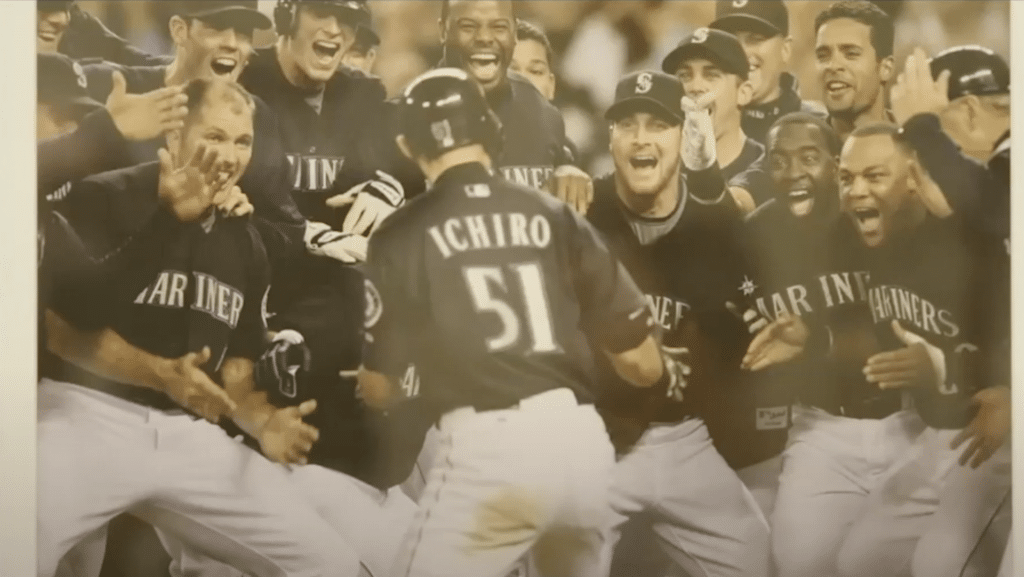
Shane:
Just because you have 40-year-old Ken Griffey, Jr. here looking like a 6-year-old, and you have Adrian Beltre from the [Dominican Republic], you got Latin guys, black and white Americans, and I feel like that picture just kind of captures what it’s all about. Here’s Ichiro, this guy from Japan, a unique, interesting guy and all these different dudes just want to jump on him and celebrate with him. That’s just kind of what it’s all about right there; none of them are caring about the country rivalries or the issues of Japanese players coming to the U.S. or the Latin American baseball problems or racial tensions, any of that stuff. So I thought that was really fun picture that I wanted to spotlight. Great choice with that one.
Yuriko:
That was part of the US embassies exhibit.
Shane:
Do we have any last-minute questions or comments?
Yumi:
I have a question for Yuriko, who was the most pleasant player you met during this process? You probably met many players but [who was] the most memorable or most pleasant that you spoke to?
Yuriko:
I have a soft spot for Mashi and for Warren Cromartie because those two guys I’ve spent a lot of time with, although Rob’s probably snickering in the background, because Mashi and I can get on each other’s nerves, but we’ve spent a lot of time and he now treats me like his [honorary] goddaughter. Aoki-san (Norichika Aoki) was really, really wonderful and I had wanted him to be sort of a bigger character, but he left the Giants and he bounced around, went to a bunch of other teams, and now he’s back in Japan. So I don’t know how much I’m gonna actually be able to use him as a character. But he was very warm and giving of his time. And I thought he had some really insightful things to say about appreciating, having experienced and lived in both countries. So I really liked that. And some of some of the more famous guys were nice. They’re in their own world. But I thought he was really wonderful.
Shane:
That is good to know. And Aoki is further cementing himself in legend status every year as he keeps doing it for so many years. So that’s cool to hear that he’s such an accommodating guy and appreciative of his experiences. We’ve been here for a while, so thank you all for sticking around. Thank you all for joining us, this was really fun. Thank you, Yuriko. This is really a treat to see these never-before-seen clips [and] to hear your stories. I’m sure we all – if we didn’t know about the project already – are going to be paying close attention, hopefully via the newsletter and all your social media channels.
Yuriko:
Thank you, Shane. I really enjoyed hanging out with you guys, and I look forward to partnering with you and maybe one day we’ll go to a ballgame in Japan together.
(Editor’s Note: Diamond Diplomacy does not currently have a release date, and is partnering with JapanBall and “Chatter Up!” to ask for donations so it can be finished and be released in the near future. More information about the film, along with links to donate and receive prizes for donations, can be found at their website: diamonddiplomacy.com .)
More discussions about Japanese Baseball can be found on our website.

